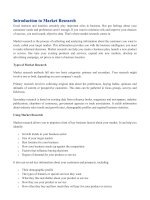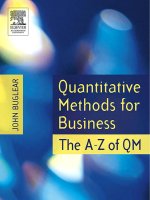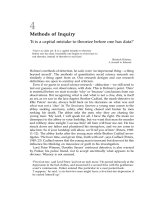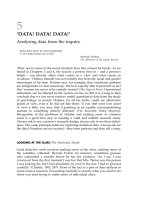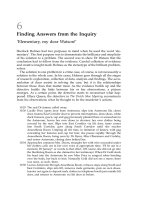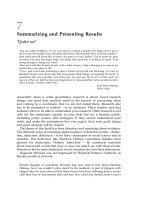INTRODUCTION TO QUANTITATIVE RESEARCH METHODS CHAPTER 1 ppsx
Bạn đang xem bản rút gọn của tài liệu. Xem và tải ngay bản đầy đủ của tài liệu tại đây (241.36 KB, 24 trang )
INTRODUCTION TO
QUANTITATIVE
RESEARCH METHODS
INTRODUCTION
TO QUANTITATIVE
RESEARCH
METHODS
AN INVESTIGATIVE
APPROACH
MARK BALNAVES and
PETER CAPUTI
SAGE Publications
London . Thousand Oaks . New Delhi
# Mark Balnaves and Peter Caputi 2001
Introduction # Alec McHoul 2001
First published 2001
Apart from any fair dealing for the purposes of research or
private study, or criticism or review, as permitted under
the Copyright, Designs and Patents Act, 1988, this
publication may be reproduced, stored or transmitted in
any form, or by any means, only with the prior permission
in writing of the publishers, or in the case of reprographic
reproduction, in accordance with the terms of licences
issued by the Copyright Licensing Agency. Inquiries
concerning reproduction outside those terms should be
sent to the publishers.
SAGE Publications Ltd
6 Bonhill Street
London EC2A 4PU
SAGE Publications Inc
2455 Teller Road
Thousand Oaks, California 91320
SAGE Publications India Pvt Ltd
32, M-Block Market
Greater Kailash-I
New Delhi 110 048
British Library Cataloguing in Publication data
A catalogue record for this book is
available from the British Library
ISBN 0-7619-6803-2
ISBN 0-7619-6804-0 (pbk)
Library of Congress catalog record available
Typeset by Keyword Publishing Services Limited, UK
Printed in Great Britain by The Cromwell Press Ltd,
Trowbridge, Wiltshire
Contents
Acknowledgements xiii
Permissions xiv
1 Order at all Points: Counting and accounting 1
The Ql-Qt Continuum 1
Culture and the Reliability of `Data' 5
References 8
2 Starting the Inquiry: `But what happened then?' 10
Knowing What to Research 16
Exploration, Description and Explanation 16
Topics of Research 20
Knowing Whom to Research 21
Units of Analysis 21
Knowing How to Research 22
Literature Review 22
Secondary Analysis 25
Knowing When to Research 25
The Importance of Time 25
Research design 27
Summary 27
The Statistical Inquirer 29
Main Points 29
Review Exercises 30
References 31
3 De®ning the Inquiry: `Then how do you know?' 33
Tools of Methodology 34
Styles of Reasoning (deduction, induction and abduction) 36
Causality 40
Mapping Relationships 41
Tools of Measurement 44
What are Variables? 45
Operational Definitions 48
Contemporary Views on Measurement 50
Great Sociological Detective Stories:
Collecting Data Across Cultures: Can we measure cultural variation?
Culture's Consequences (Geert Hofstede) 51
Methodology and Theory 52
Method 53
Hypotheses and Operationalization 53
v
CONTENTS
Variables 55
Individualism and Masculinity 55
Power Distance 56
Uncertainty Avoidance 57
Summary 59
Main Points 61
Review Exercises 61
References 62
4 Methods of Inquiry: `It is a capital mistake to theorize before one
has data!' 64
Involvement and Method 65
Experimental Design 67
Different Types of Experimental Design 74
Survey Design 75
What is a Survey? 76
The Variable in Question 77
Nominal Variables/Questions 77
Ordinal Variables/Questions 78
Interval Variables/Questions 78
Ratio Variables/Questions 79
Multiple-Item Scales 79
Differential Scales 79
Cumulative Scales 80
Summative Scales 80
The Words in the Question 81
Administering the Questionnaire 84
Layout 84
Length of Questionnaire 85
Interview as Measurement 86
Validity 87
External Validity and Sampling 90
Population and Sampling Frame 91
Simple Random Sampling 91
Stratified Random Sampling 92
Multi-Stage Cluster Sampling 92
Sample Size 93
Non-Probability Sampling 95
Trade-Offs 95
Triangulation 95
Great Media and Politics Detective Stories:
Using Survey Data. Do media change people's political attitudes?
The People's Choice (Paul Lazarsfeld) 96
Methodology and Theory 97
Method 98
Hypotheses and Operationalization 98
Variables 100
vi
CONTENTS
Summary 103
Main Points 105
Review Exercises 106
References 106
5 `Data! Data! Data!': Analysing data from the inquiry 109
Looking at the Clues: The Statistical Sleuth 109
Why Explore Data? 110
Plotting Data 110
Stem and Leaf Displays 110
Example 5.1: Stem and leaf display 111
Histograms 113
Boxplots 115
Tables, Graphs and Figures 118
Does a Picture Always Paint a Thousand Words? Some issues with
representing data in graphical and tabular form 120
Using SPSS and Excel to Plot Data: Accounting for Tastes dataset 122
Methodology and Operationalization 123
Working with SPSS 124
Working with Excel 131
Describing Data 132
Numerical Summaries: What are they and why are they important? 132
Describing Location or Centrality 133
Some Notation 133
Example 5.2: Calculating the median of odd and even
numbered distributions 134
Mean vs Median (When is the evidence not contaminated?) 134
Describing Variability 135
Example 5.3: Calculating the variance of a set of values 137
Using SPSS and Excel to Describe Data 138
Working with SPSS 138
Working with Excel 140
Summary 142
Main Points 143
Review Exercises 144
References 145
6
Finding Answers from the Inquiry: `Elementary, my dear Watson!'
147
Looking at Bivariate Data, Correlation and Regression 149
Plotting Bivariate Data 149
Correlation: a Measure of Co-Relation 151
Example 6.1: Computing the correlation coefficient 154
Introduction to Simple Linear Regression 156
Prediction and Correlation 156
Method of Least Squares 157
Example 6.2: Finding the regression line 159
Assessing the Fit of the Regression Model 160
Issue of Causation 161
vii
Using SPSS: Correlation and Regression 163
Using Excel 168
Looking at Categorical Data 171
Exploring Bivariate Categorical Data 171
Example 6.3: Computing the contingency coefficient 174
Inference: From Samples to Populations 175
Parameters, Estimates and Statistics 176
Sampling Distributions 177
Hypothesis Testing ± Don't just show me the evidence, convince me
that it is so! 180
One-Sample Tests 180
One-Sample Test for Categorical Data 183
Two-Sample Tests 185
Test of Equality of Means for Independent Samples 185
Example 6.4: t-test for independent samples 186
Rank Test for Independent Samples 189
Example 6.5: Rank test for two independent groups 190
Tests for Categorical Data 191
Tests for Related Samples 193
Rank Test for Correlated or Related Samples 195
Using SPSS and Excel: One-Sample Tests 196
Using SPSS and Excel: Two-Sample Tests 201
Introduction to Randomization Tests 211
Great Social Biology Detective Stories: `We must hunt for cases' 213
Is There An Ideal Person?: Quetelet, Galton, Pearson 214
Does a General Intelligence Factor Exist?:
Spearman and the introduction of correlation 215
Is There a Genetic Component to Intelligence?
Did Burt clone the data? ± data ain't always data!! 217
Are Social Factors More Important than Individual Inclinations?
Durkheim's study on suicide (The use of secondary data) 218
Summary 223
Main Points 224
Review Exercises 225
References 227
7 Summarizing and Presenting Results: `Quite so!' 229
Reporting Empirical Research 232
Writing Style, Narrative Style 234
Detection and Deception 235
References 236
Appendix I: Sample Letter for Informed Consent 237
Appendix II: BSA Statement of Ethical Practice 239
Appendix III: The Statistical Inquirer 246
Index 249
CONTENTS
viii
Tables
Table 2.1 Impact of television on Western Samoan evening activities,
4±10 pm 20
Table 2.2 Time and research design 26
Table 2.3 Organizing a quantitative research study 28
Table 3.1 From construct to operational definition 54
Table 3.2 Actual questions used to construct individualism/masculinity
indexes 54
Table 3.3 Countries ranked by individualism scores 56
Table 3.4 Countries ranked by masculinity scores 56
Table 3.5 Countries ranked by power distance scores 57
Table 3.6 Countries ranked by uncertainty avoidance scores 58
Table 4.1 Effectiveness of Program A and B for men with initially
unfavourable and men with initially favourable attitudes 74
Table 4.2 Effectiveness of Program A and B for men of different
educational backgrounds 74
Table 4.3 Examples from Thurstone's differential scale 80
Table 4.4 Examples from Bogardus Social Distance scale 80
Table 4.5 Selected examples from Christie and Geis's Likert scale 81
Table 4.6 Sample questionnaire and coding column 86
Table 4.7 Rank order of French high school students' intelligence scores
obtained with three hypothetical measures 89
Table 4.8 Table of random numbers 92
Table 4.9 Random selection of households for interview 94
Table 4.10 Summary of sampling procedures 94
Table 5.1 Example of back-to-back plot 113
Table 5.2 Frequency distribution table for grouped data 114
Table 5.3 Hypothetical data for variables X and Y 117
Table 5.4 The anatomy of a table 120
Table 5.5 Mean ratings of intensity of emotion 122
Table 5.6 Reframed data: mean ratings of intensity of emotion 122
Table 5.7 Accounting for tastes: comparison of stratified sample with
official statistics 124
Table 6.1 Hypothetical data 149
Table 6.2 Hypothetical data on correlation between years of counselling
experience and effective outcome 154
Table 6.3 Data with outliers 156
Table 6.4 Distribution of votes by section 172
Table 6.5 Percentage of votes within each section 172
Table 6.6 A 2 Â 2 contingency table 173
Table 6.7 Data for job performance and EC test 174
Table 6.8 Computational details for Table 6.7 175
Table 6.9 Some commonly used values from a set of normal tables 182
Table 6.10 Frequencies in colour and shape of peas 184
Table 6.11 Hypothetical data for number of successful free throws in two
conditions 185
Table 6.12 Descriptive statistics 187
Table 6.13 Frequencies relating to marital status and IQ 192
Table 6.14 Comparison of observed and expected frequencies for
Baller's data 192
Table 6.15 Hypothetical data for speech anxiety scores in two
conditions 194
Table 6.16 All possible permutations of six scores in two conditions 212
Table 6.17 Permutation distribution for data in Table 6.16 213
Table 6.18 Suicides in different countries per million persons of each
confession 220
Table 6.19 Influences of the family on suicide, unmarried men 221
Table 6.20 Influences of the family on suicide, unmarried women 221
Table 7.1 Example from Accounting for Tastes: combined music genre
preferences by gender 233
TABLES
x
Figures
Chart 1.1 Reports on Aboriginal youth and all youth-crime reports,
Feb. 1991 to Jan. 1992 3
Chart 1.2 News reports on Aboriginal youth-crime and all youth-crime
with actual crime data, Feb. 1991 to Jan. 1992 4
Figure 2.1 From assertions to evidence 23
Figure 3.1 Operationalization 48
Figure 4.1 Methods of data collection and personal involvement 65
Figure 4.2 Checklist for research design 66
Figure 4.3 Research methods and techniques of data collection 67
Figure 4.4 Basic experimental design 69
Figure 4.5 Different answering formats 84
Figure 4.6 Contingency questions 84
Figure 4.7 Factors affecting people's motivation to provide complete and
accurate information to the interviewer 87
Figure 4.8 Checklist for questionnaire design 88
Figure 4.9 Multi-stage cluster sampling ± following the census
tracts 93
Figure 4.10 Experimental choice based on issues of internal and external
validity 96
Figure 4.11 Whereas actual occupation does little to refine the relationship
between SES level and vote, it makes more difference whether
a voter considers himself as belonging to `business' or
`labour' 100
Figure 4.12 Religious affiliation splits the vote sharply 101
Figure 4.13 One-step model of mass-media influence 102
Figure 4.14 Two-step model of mass-media influence 102
Figure 4.15 Inductive approach 104
Figure 4.16 Deductive approach 104
Figure 5.1 A stem and leaf display of ESP data 114
Figure 5.2 Histogram of hypothetical examination marks 115
Figure 5.3 The anatomy of a boxplot 116
Figure 5.4 Boxplots for two hypothetical variables X and Y 117
Figure 5.5 Side-by-side boxplots 118
Figure 5.6 Preference for telecommunications carrier 121
Figure 5.7 A different way to display preference for telecommunications
carrier 121
Figure 6.1 Scatterplot for data in Table 6.1 150
Figure 6.2 Negative association between two variables 150
Figure 6.3 No relationship between two variables 151
Figure 6.4 Scatterplot showing an outlier 151
Figure 6.5 A curvilinear relationship 155
Figure 6.6 Fitting a line through points on a scatterplot 157
Figure 6.7 Illustrating the concept of residual 158
Figure 6.8 Bar chart of frequency of votes by selection 172
Figure 6.9 Bar chart of raw percentage of votes by selection 173
Figure 6.10 The normal distribution of a normal curve 179
Figure 6.11 The t-distribution 183
Figure 6.12 Durkheim's theoretical hypothesis on suicide 220
Figure 6.13 Durkheim's hypothesis of degree of integration 221
Figure 6.14 Durkheim's hypothesis of degree of regulation 222
FIGURES
xii
Acknowledgements
A special thanks to:
Gary Bouma and David DeVaus
Mark Busani, Nick Castle and Monica Vecchiotti for their help with the
multimedia courseware.
Maurice Dunlevy, for contributions on journalism, and Harry Oxley, for
contributions on causal diagramming.
Patrick Rawstorne for use of his PhD dataset Predicting and Explaining the
use of Information Technology with Value Expectancy Models of Behaviour
in Contexts of Mandatory Use.
Erika Pearson ± it's hard to find good help nowadays.
Tony Bennett, Mike Emmison and John Frow for use of their dataset from
The Australian Everyday Consumption project.
SPSS illustrations have been reprinted by SPSS copyright permission. Excel
illustrations have been reprinted by Excel copyright permission.
The Apple University Consortium and PCTech for their equipment and
software support.
The Australian National Library for assistance with access to The Strand,
from which the original Paget sketches of Sherlock Holmes were repro-
duced for this book.
Alec McHoul, Mike Innes, Joyce and Michele Balnaves, Wendy Parkins and
James Donald, who provided valuable insights into detection.
John and Paul Balnaves on questions of Shakespeare and logic.
Michele, Mary-Claire, Gerard, Elayne, James, and Jack.
Douglas Adams ± the bottle of red has been sent.
The authors of detective fiction.
Permissions
The authors and publishers wish to thank the following for their permission
to use copyright material:
Tables 6.16 and 6.17. Copyright # 1993. Canadian Psychological
Association. Reprinted with permission.
Page 12, extract from The Strange Crime of John Boulnois by G.K. Chesterton.
Used by permission of A.P. Watt on behalf of The Royal Literary Fund.
Page 14, extract from Dirk Gently's Holistic Detective Agency by Douglas
Adams. Used by permission of Douglas Adams. Copyright # 1987.
Heinemann.
Figure 2.1. From Evaluating Social Science Research, second edition, by Paul C.
Stern and Linda Kalof. Copyright # 1979, 1996. Oxford University Press,
Inc. Used by permission of Oxford University Press.
Table 2.2. Used by permission of Gary Bouma. Copyright # 1993. The
Research Process. Oxford University Press.
Page 38, extract from The Blue Cross by G.K. Chesterton. Used by permission
of A.P. Watt on behalf of The Royal Literary Fund.
Figure 4.3. Used by permission of David DeVaus. Copyright # 1990.
Surveys in Social Research. Allen and Unwin.
Table 4.7. From Research Methods in Social Relations, sixth edition, by Charles
M. Judd, Eliot R. Smith and Louise H. Kidder. Copyright # 1991, Holt,
Rinehart and Winston. Reproduced by permission of the publishers.
Every effort has been made to trace all copyright holders, but if any have
been overlooked, or if any additional information can be given, the publish-
ers will be pleased to make the necessary amendments at the first oppor-
tunity.
1
Order at All Points
Counting and accounting
A man is driving through the bush one day and has to stop while a farmer takes his sheep
across the road. There are quite a lot of sheep, so it takes a fair while. When they've all
passed by, the man goes up to the farmer and asks, `If I can tell you how many sheep you
have, to within one either way, can I have one of them?' The farmer replies, `Course you
can. You'll never get it right.' The man says, `You have six thousand four hundred and
twenty two.' `Well blow me down,' replies the farmer ± or words to that effect. `In fact I
have six thousand four hundred and twenty one. I counted them this morning.' So the man
walks back to the car with his prize.
`Wait on,' cries the farmer. `If I can tell you what your job is, can I have her back?' `Sure,'
says the man, `You'll never guess.' `Well,' says the farmer, `I figure you'd be a statistician
with the Australian Bureau of Statistics.' `Well I'll be FFF3' the man replies, `Exactly right.
How on earth did you know that?'
The farmer comes back: `Put me dog down and I'll tell you.'
Traditional Australian Bush Yarn
THE Ql-Qt CONTINUUM
1
Like many in the humanities and social sciences, I was trained to be (at the
least) sceptical about statistical methods and (at most) downright hostile
towards them. In sceptical mode, I was exhorted to use statistics not in the
way a drunk uses a lamppost: for support rather than illumination. In
hostile mode, the word was that statistics was for `positivists' (a very unfair
characterization, as it turns out, of positivism). What all of this well-mean-
ing and humanistic advice ignored was the sheer fact that our social and
cultural worlds, today, are massively subject to statistical accounts (see
Hacking, 1982). Whenever we turn on the TV news or open a newspaper,
the world is now routinely accounted for in terms of the numbers it gen-
erates: from world population statistics right down to chewing gum mar-
kets. In this respect, it's not quite as if numbers were on one side of the coin
and `lived cultures' on the other. Rather, the technologies of numbering
have become just one (though, in some disciplines, a dominant one) of
the many practices that make up the cultures of modernity. In this brief
introduction, then, I want to think through the supposed distinction (binary,
even) between the quantitative (Qt) and the qualitative (Ql) and to show
that the seal between the two is by no means as watertight as it is often
assumed to be.
My first realization of an elision between Qt and Ql came to me when, out
of sheer impecuniousness, I went to work for the Survey Research Centre at
the Australian National University (ANU) in the mid-1970s. Prior to this
way of supplementing my meagre PhD scholarship, my only encounter
with statistics had been the compulsory undergraduate methods course
in sociology, taught, as it happened, by a died-in-the-wool symbolic inter-
actionist, a Ql-man if ever there was one! Said lecturer was, then, very
happy for me to complete my statistics assignments by having a friend
who was a physics student crunch the exercises on the university's one
mainframe computer by submitting bundles of punchcards. Not, then,
exactly the best of trainings or qualifications, I admit. But working late at
ANU, designing and administering the Australian Capital Territory (ACT)
population surveys, I came to see what a symbolic and interactional process
Qt work could be in practice. One of our clients at the time was the local
Family Planning organization. It wanted to know which forms of contra-
ception were most in use in the Capital Territory. The only problem with
this was that the official sampling procedures required interviewers to
jointly interview two members of each household selected (using lot num-
bers) on a rotational basis: oldest and third oldest in odd-numbered lots,
and second oldest and fourth oldest in even-numbered lots. This meant, in
effect, that a fair proportion of interviews involved parents and their older
children ± not exactly the best interactional setting to ask people about their
contraceptive practices. The problem was both, and equally, statistical and
`cultural.' Qt and Ql could not be a simple binary. And, oh yes, the wonder-
ful `solution' we developed was to draw up a card with each kind of contra-
ception numbered. Respondents were then shown the card and would say
such things as `Well, I tried the number seven but it didn't work for me, so
now I prefer the twenty six.'
The same realization came back to me during a more recent research
project (Mickler and McHoul, 1998). In this project, we collected over 600
newspaper articles on Aborigines, youth and crime over a 12-month period
in the early 1990s in order to see whether there had been, as some suspected
at the time, a media-generated `crime wave.' We had a neutral reader/
research-assistant type the articles into a relational database program
(QSR NUDEIST) and, at the same time, code the articles for such things
as `source' (the origin of the reported events), `participants' (the categories
of persons reported on in each article) and how the reader thought the
article was treating such `participants' (in positive, negative or neutral
moral terms). What we hoped to get out of this was a strongly Ql argument
based on a discursive analysis of the news articles and their `readings.'
However, before long, we found that working with over 600 texts would
not allow us to do this. The data in question were simply too numerous.
And anyway, NUDEIST was starting to generate matrices of such things as
`Date of publication' Â`Article source' and `Newspaper' Â`Participants.'
Each cell of the matrix listed the relevant articles by their unique
NUDEIST document number. There was no way we could work with this
BALNAVES AND CAPUTI
2
kind of output in a purely Ql mode. We had to show our findings graphi-
cally. This meant a lot of arduous work, transferring the totals of each cell
into an Excel spreadsheet and then having Excel generate graphs and bar
charts. (This was in NUDEIST version 3: the day we finished our gruelling
transcription work, NUDEIST 4 was released, including new software that
automatically converts such findings into popular spreadsheet and stats
programs.) At that point we were able to generate `findings' such as
those in Chart 1.1.
This was very useful to us because it showed us a picture of the year's
news in terms of just when the WA press was reporting youth crimes, and
the months during which young Aboriginal people were the `participants'
in those reports. However, while this could show us the media angle, it
could not tell us whether or not the `peaks' of youth crime reportage (and
we were particularly interested in the September peak because it followed
the infamous Rally for Justice outside Parliament House in the August)
corresponded to `actual' crime rates. If we were going to find a `media
wave,' we would have to overlay crime stats on to our bar chart. We even-
tually tracked these down at the University of Western Australia Crime
Research Centre whose staff kindly gave us their raw figures for the
12-month period in question. Accordingly we could then generate more
conclusive findings about the supposed `wave' ± see Chart 1.2.
ORDER AT ALL POINTS
0
5
10
15
20
25
30
35
FEB
'91
MAR APR MAY JUNE JULY AUG SEP OCT NOV DEC JAN
'92
Date in Months
No. of News Reports
Reports on Aboriginal Youth All Youth-Crime Reports
CHART 1.1 Reports on Aboriginal youth and all youth-crime reports, Feb.1991t o Jan.1992
3
So we now had something like a `media wave.' That is, as the reportage of
youth crime peaked in September there was a corresponding decline in
`actual' crimes as measured by apprehensions and reports to the police.
Again, we could only see this graphically ± though later we resorted to a
more Ql discussion of how, in terms of routine media practices, the `wave'
could have been generated. That is, we wanted to show, from a close read-
ing of the reports (in line with well-known facts about the news profession
(Ericson et al., 1987, 1989, 1991)) that the statistically visible `wave' was not
so much a conscious conspiracy as a routine phenomenon in the field of
`bad news as usual.' As so frequently, the raw stats were open to more than
one interpretation and only one of these was that the media were `deliber-
ately' causing the appearance of a crime wave with possibly suspect and
populist motives.
Working on this project, then, brought me to the realization that there is in
fact a continuum between hypothetically `pure' Qt and Ql analysis. The
two, that is, never actually exist, empirically, in their pure states. Qt work
is part of the `culture' at large and Ql work is never strictly free of numbers.
So why then is there an effective stand-off between professionals in the two
methodological fields? Why do some Qt workers insist on accepted
sampling procedures and statistical reliability while some Ql workers
BALNAVES AND CAPUTI
0
10
20
30
40
50
60
70
FEB '91 MAR APR MAY JUNE JULY AUG SEPT OCT NOV DEC JAN
'92
Date in Months
No. of News Reports (10=10), No. of Apprehension
(10=100) and No. of Offences Reported to Police
(10=1000)
Aboriginal Youth-Crime Reports
All Youth-Crime Reports
All Juvenile Apprehensions
Aboriginal Juvenile (Male) Apprehensions
Stolen Motor Vehicles, Break and Enter and Burglaries Reported to Police
(Crime Statistics Sources: Broadhurst and Ferrante (1995: 87); Broadhurst and Loh (1995: 72))
CHART 1.2 News reports on Aboriginal yout h-crime and all youth-crime with actual crime data,
F eb. 1991 to Ja n. 19 92
4
argue that very small fragments of cultural `data' (a poem, a few turns at
talk, an advertisement, and so on) can generate just as fruitful findings? In
order to begin to answer this question, we can turn to a rather extreme case
of an anti-Qt argument. The one I have in mind was mounted some years
ago by another major influence on my own methodological preferences:
Harvey Sacks.
CULTURE AND THE RELIABILITY OF `DATA'
2
Just as in physics, natural phenomena must be massively sampled before an
argument about their properties can be mounted, so, in some branches of
the social sciences, cases must be sufficiently large in number before gen-
eralizations can be acceptable to the professional community. The parallel is
both noble and mistaken, according to several social theorists of (roughly)
a phenomenological persuasion. Alfred Schu
È
tz, many years ago, and in
works that are almost unknown to Qt types today, put this argument
very simply (Schu
È
tz, 1962: 34-47). He noticed that natural scientists deal
with objects of the first order of interpretation: that is, the objects that the
natural scientist has before her have not been interpreted until she herself
shows up on the scene. Atoms, planets and cyclones do not interpret them-
selves. However, as soon as we come to deal with human individuals or
populations, we're in a different situation entirely. These `objects of know-
ledge' have interpreted themselves before the social scientist comes on the
scene. They are therefore `objects' of the second order of interpretation. They
come pre-interpreted ± and so the job of anyone working in the human
sciences is to interpret the interpretations that people have already made
of their lives (individually) and their cultures (collectively). Where human
beings are concerned (as opposed to rats or atoms), the investigator is
always investigating `second order' matters. It is a fundamental category
mistake, then, to treat humanly produced data as `natural' data ± though,
as we will see shortly, this logical error need not preclude Qt analysis
altogether: I am simply taking this argument as one of the most cogent to
date on the underlying `philosophy' of much Qt thinking.
Sacks's important intervention into this debate ± possibly via his associ-
ation with Garfinkel (1967) who was, in turn, majorly influenced by Schu
È
tz
± is to argue for a unique position for cultural `data.' Not only, he ventures,
is culture distinct from nature, it also has unique orderly properties. That is:
in coming to analyse human cultures, one must take into account that they
display `order at all points.' The argument is complex and students would
do best to consult the original (1995: 484). However, Schegloff (who intro-
duces both volumes) puts the matter succinctly. Accordingly, I quote at
length:
Considerations of enculturation and `language acquisition' provide an especially
provocative focus for a matter which Sacks raises FFF as a methodological point.
ORDER AT ALL POINTS
5
Taking up the relevance of sampling, Sacks points out that it depends on the sort
of order one takes it that the social world exhibits. An alternative to the possibility
that order manifests itself at an aggregate level and is statistical in character is
what he terms the `order at all points' viewFFF . This view, rather like the `holo-
graphic' model of information distribution, understands order not to be present
only at aggregate levels and therefore subject to an overall differential distri-
bution, but to be present in detail on a case by case, environment by environment
basis. A culture is not then to be found only by aggregating all of its venues; it is
substantially present in each of its venues. (Schegloff in Sacks 1995: xlvi)
As with holographs, a culture must display its inherent order, no matter
how much or little of it we happen to examine or `sample.' (And, as we will
see shortly, this importantly applies as much to the `much' as it does to the
`little.') Even if 99 per cent of a holographic image is destroyed, the remain-
ing 1 per cent contains all of the information contained in the original whole
(Roe, 1998). In this respect, when we are dealing with social and cultural
phenomena (such as `mental illness' or `suicide,' for example), the question
of whether we have sufficient cases for the `data' to be `reliable' may not
arise. The order we are seeking, as social scientists or cultural analysts,
according to Sacks, is not available as a form of statistical aggregation;
rather it must be inherently present in whatever materials happen to be
at hand ± for example just a few turns in a conversation. And, in fact,
Sacks directly uses his `order at all points' (or `in all venues') model to
criticize Qt research. His argument here is particularly directed at sociology
and survey research, but it applies equally well to the other social sciences:
FFF you might find that the fact of `order at all points' could be used to explain
fairly strange facts; things like the following. For one, certain kinds of researches ±
for example, let's say, taking very conventional sociology, survey research ± would
use the fact that it gets orderly results to indicate that it must be doing something
decent. Now everybody knows ± that is, everybody who has ever done such work,
or studied it ± that it's almost universally extremely bad; that almost never can
whatever the constraints are that ought to be used under their own formulation to
decide that they have something, be used. There are, for example, all kinds of
constraints on proper statistical procedures which are never satisfied, and none the
less they get order. (1995: 484, my emphasis)
The argument here is important: the reason why Qt procedures arrive at
orderly outcomes may not be because of the `reliability' of either the sample
or the statistical techniques deployed on that sample. Rather, the order that
arises would be, for Sacks, an effect of the fact that, wherever a culture is
tapped into, and however frequently or infrequently it is sampled, it will
display its inherent order. If this is the case ± and I have yet to see a social
theory that directly defends an aggregationist model against the idea of
`order at all points' ± then statistically reliable results may well be nothing
more than a case of something intrinsically non-statistical showing through
(and despite) the sampling techniques employed in any given case. The
BALNAVES AND CAPUTI
6
consequences of such a `paradigm shift' are potentially massive for social
scientific thinking ± not least because they might change our thinking away
from what Wittgenstein (1958b: 18) called our `craving for generality' and/
or `the contemptuous attitude towards the particular case' (cf. Turner,
1974: 213).
However, none of this means that Qt work is without value.
3
On the
contrary, as we have seen in our first section of this introduction, statistical
representations are sometimes inevitable: and in the above case, the reason
for this had to do with the necessarily longitudinal nature of the `media
wave' hypothesis. If this is so ± and because Ql and Qt exist on a continuum
and not as strict alternatives ± then even the most Ql-oriented researchers
will occasionally find themselves needing to use statistical models and their
ensuing graphic representations. If the `continuum' argument holds up
(and I think it does, at least from experience), then how can this live in
the same world as the `order at all points' argument?
Sacks himself gives us the answer when he writes that, even when we do
proceed statistically, and even in its crudest form (the survey), we will find
the same cultural order as when we do not! `None the less they get order' is
precisely what he tells us. That is, if cultural `data' is intrinsically data of the
second order, any statistical analysis of it cannot help but preserve that aspect
of it. The `philosophy' of treating social and cultural phenomena as if they
were natural phenomena may well be a philosophical error ± associated
(probably wrongly) with `positivism.' But this does not mean that the
methods that flow from that error can somehow delete the orderly cultural
properties of the former kind of phenomenon. In fact, Sacks himself tells us
that they could not even if they wanted to.
This then sets the tone ± or more precisely, the `analytic mentality'
(Schenkein, 1978) ± for the following chapters of this book.
4
They introduce
some central social and cultural uses of Qt methods and, at the same time,
always remember the importance of the `order at all points' that such
uses must bring out. Or to put this another way: there is no logical reason
why Qt methods can't be just as informed by a Sacksian view of cultural
order as they can by starting `positivistically' with physics envy. The result
is, I think, the first textbook in the field to bring cultural responsiveness
to statistical methods and, equally, statistical responsibility to cultural
analysis.
Alec McHoul
Murdoch University
6th January 2000
NOTES
1. This sub-title with apologies to Star Trek TNG. In many way, Star Trek's Q is the
ultimate detective. His case is nothing more or less than the human condition.
ORDER AT ALL POINTS
7
2. This section is based on parts of an article on Sacks, conversation analysis and
psychology by Alec McHoul and Mark Rapley (2000). For a good general intro-
duction to Sacks, see Silverman (1998).
3. For example, the foundational text of ethnomethodology, Garfinkel's Studies in
Ethnomethodology (1967), extensively uses statistical and quasi-statistical represen-
tations to show `experimental' results.
4. I write `more precisely' with half an eye on the problem of what `precision' could
mean on the Ql±Qt continuum. To explain: the term `analytic mentality' is from
Jim Schenkein (1978). He writes: `I am never entirely sure of what I mean by
``analytic mentality'', but then goes on to say: `I have come to think of [our] shared
practices [in conversation analysis] as ingredients in an ``analytic mentality'' since
other more familiar terms fail to capture the spectrum of ingredients sketched
here. Our particular grouping of shared dispositions is not exactly a ``theory'' or
``method'', nor is it merely a ``point of view'' or some kind of ``philosophy''. But
whatever it is, the result is a research environment FFFand ``analytic mentality'' is
fuzzy enough to embrace whatever comes up when a closer look at the environ-
ment is taken' (1978: 6). So this fuzzy formulation seems to be, paradoxically
perhaps, a more precise description than terms like `theory' and `method'. This
would be exactly my characterization of work that explicitly acknowledges and
works along the Ql±Qt continuum. As Wittgenstein (1958a: #71) puts it: `Is it FFF
always an advantage to replace an indistinct picture by a sharp one? Isn't the
indistinct one often exactly what we need?'
REFERENCES
Broadhurst, Roderic and Ferrante, Anna (1995) `Trends in juvenile crime and justice,
1990±1992', in R. Harding (ed.) Repeat Juvenile Offenders: The Failure of Selective
Incapacitation in Western Australia. Nedlands, WA: Crime Research Centre,
University of Western Australia. pp. 79±95.
Broadhurst, Roderic and Loh, Nini Sui Nie (1995) `Selective incapacitation and the
phantom of deterrence', in R. Harding (ed.) Repeat Juvenile Offenders: The Failure of
Selective Incapacitation in Western Australia. Nedlands, WA: Crime Research Centre,
University of Western Australia. pp. 55±78.
Ericson, Richard, Baranek, Patricia and Chan, Janet (1987) Visualizing Deviance: A
Study of News Organization. Toronto: University of Toronto Press.
Ericson, Richard, Baranek, Patricia and Chan, Janet (1989) Negotiating Control: A
Study of News Sources. Stony Stratford: Open University Press.
Ericson, Richard, Baranek, Patricia and Chan, Janet (1991) Representing Order: Crime,
Law, and Justice in the News Media. Buckingham: Open University Press.
Garfinkel, Harold (1967) Studies in Ethnomethodology. Englewood Cliffs: Prentice-
Hall.
Hacking, Ian (1982) `Biopower and the avalanche of printed numbers', Humanities in
Society, 5 (3/4): pp. 279±95.
McHoul, Alec and Rapley, Mark (2000) `Sacks and clinical psychology', Clinical
Psychology Forum, 142 (August): pp. 5±12.
Mickler, Steve and McHoul, Alec (1998) `Sourcing the wave: Crime reporting,
Aboriginal youth and the WA Press, Feb 1991±Jan 1992', Media International
Australia incorporating Culture and Policy, 86 (February): pp. 122±52.
BALNAVES AND CAPUTI
8
Roe, Phil (1998) Of Hologrammatology: The Politics of Virtual Writing. Unpublished
PhD thesis, Murdoch University.
Sacks, Harvey (1995) Lectures on Conversation, Vol. 1. Ed. G. Jefferson, intro. E.A.
Schegloff. Oxford: Blackwell.
Schenkein, Jim (1978) `Sketch of an analytic mentality for the study of conversational
interaction', In J. Schenkein (ed.) Studies in the Organization of Conversational
Interaction. New York: Academic Press. pp. 1±6.
Schu
È
tz, Alfred (1962) Collected Papers Vol. 1: The Problem of Social Reality. Ed. and
intro. M. Natanson. The Hague: Martinus Nijhoff.
Silverman, David (1998) Harvey Sacks: Social Science and Conversation Analysis.
Cambridge: Polity Press.
Turner, Roy (1974) `Words, utterances and activities', in R. Turner (ed.)
Ethnomethodology: Selected Readings. London: Penguin. pp. 197±215.
Wittgenstein, Ludwig (1958a) Philosophical Investigations. 2nd edn. Trans. G.E.M.
Anscombe. Oxford: Blackwell.
Wittgenstein, Ludwig (1958b) The Blue and Brown Books: Preliminary Studies for the
`Philosophical Investigations'. Oxford: Blackwell.
ORDER AT ALL POINTS
9
